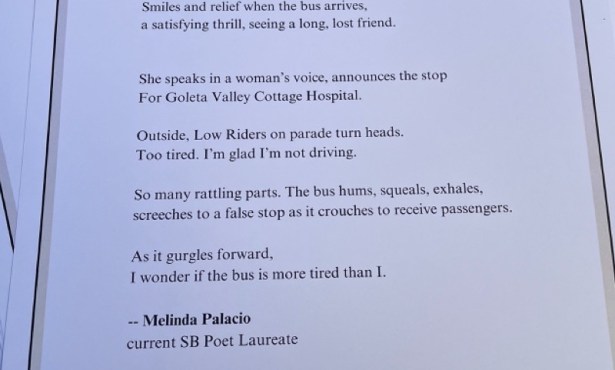In the Home of the Centaur
Touring Casa del Herrero, Montecito's Newest Historical Landmark
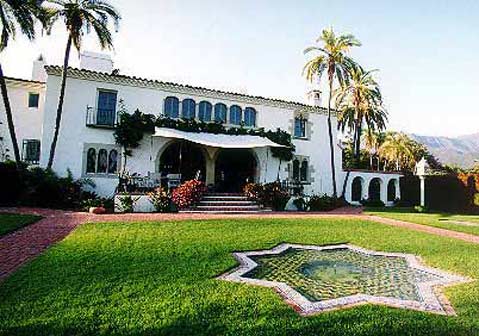
“We’ve been such a well-kept secret,” explains Molly Barker, executive director of the Casa del Herrero, while gesturing toward the white pillars that barely mark its driveway. In fact, it would be easy to drive right past the legendary grounds, which officially became a National Historic Landmark on January 16 after years of hard work and planning. Designed by architect George Washington Smith for the wealthy George Fox Steedman and completed in 1925, the “House of the Blacksmith” is a fascinating Spanish villa, tucked quietly behind hedges in Montecito, and its secret is finally getting out.
In 1993, Steedman’s grandson George Bass created a foundation to preserve the estate and make it open to the public. Guided tours started the following year, when the foundation ripped out the shag carpeting put in by a more recent member of the Steedman line, and brought all the old furniture up from the basement. Before I sat down with Barker, I was lucky enough to tag along on a tour of the estate, sharing the day with two elderly couples who vocally opposed the estate’s overabundance of stairs. The first thing our guide told us was that the eccentric George Steedman had a heavy hand himself in the design of the villa.
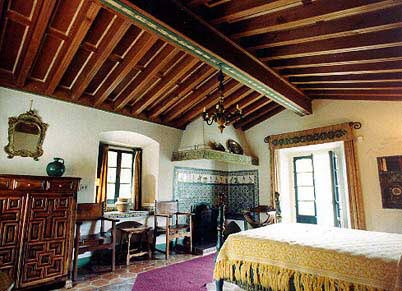
The Saintly Interior
As we enter the foyer filled with dark wood and artwork from the 16th century, the guide admits that, at first glance, Steedman’s highly organized, driven life and formidably serious face in portraiture make him seem a bit stiff. But, with a sort of not-many-people-get-Steedman-like-I-do smile, she explains that he was nothing if not whimsical. In fact, everything that Steadman designed in the casa bears his bizarre symbol: a small painting of himself as a centaur. After first looking through so many refined, black-and-white portraits of the middle-aged Steedman, seeing his face on countless painted centaurs around the house is quite charming. I find myself wondering how many other aristocrats fancied themselves magical creatures but simply lacked the painting skills to express it.
Being influenced by the culture of southern Spain – a region that has both Catholic and Moorish influences – the house is filled with religious symbols and artifacts. In the Steedman foyer, the friendly yet leering Catholic saints look down from the ceiling, while tiles along the floor bear the classic Islamic ziggurat: ascending stairs on a pyramid with no point, signifying man’s inability to reach the perfection known only to Allah.
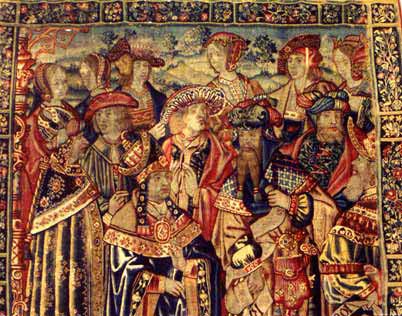
Our guide explains that Steedman, neither a Catholic nor a Muslim, made his fortune as the owner of Curtis Manufacturing, which produced munitions for Great Britain in World War I. When the United States entered the battle, Steedman – patriot over businessman – didn’t charge for his services. The war nevertheless made him a rich man, rich enough to fill every room in his house with religious antiques.
Saints are everywhere in and around the house, and in areas for which they’re famous. St. Francis is in the garden. St. Barbara, the patron saint of architects and all those in a dangerous profession – whose Christianity was made known to her furious father when she added a third window to a tower to symbolize the trinity, and whose father was later thwarted in his attempt to kill her with a broadsword when struck by the lightning of heaven – greets you with surprising serenity when you come in through the front door. Steedman, says our guide, gives St. Barbara prominence because of his respect for architecture.
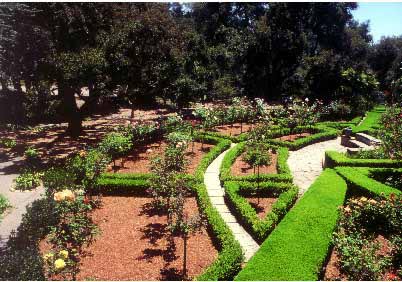
As we move from the foyer into the living room, we meet the apostles for what will not be the last time. While the saints are placed where Steedman thought fitting, the apostles keep a mournful eye on the affairs of the entire house, and can be found in most rooms. Downstairs they peer unhappily from the dark of the library to the brighter living room where they see Steedman the centaur, his hooves just above the family’s record player, painted this time playing a little harp with his grandson (who’s adorned with a fish tail to poke fun at his last name, Bass).
The dining room houses the estate’s most gruesome fixture: an enormous antique portrait of St. Lorenzo being roasted alive during dinner for giving a king’s goods away to the poor. St. Lorenzo was famous for jabbing these last words at his unjust executioners: “Turn me over, I think I’m done on this side!” And while the connection between one’s dinner and being burned alive seems valid enough, it succeeds in making a visitor uneasy and does little to stimulate the appetite. This scene hangs just above a fireplace cover that features Steedman, the centaur again, toasting a beer stein.
The apostles are at their most noticeable as we head upstairs to find them facing the doors to the family’s bedrooms, greeting the Steedmans every morning with sorrow. Even the children’s room, while bright and spacious, warrants a sigh from our guide. Feeling, evidently, that countless representations of dying saints was not quite enough history for his children, Steedman helped to paint a panoramic mural in their bedroom. The children’s mural? It is the Battle of Hastings. And of course, among the dying English and Norman knights is Steedman himself, raising a spear in the tumultuous battle, the steady old aristocrat a glorious leaping centaur.
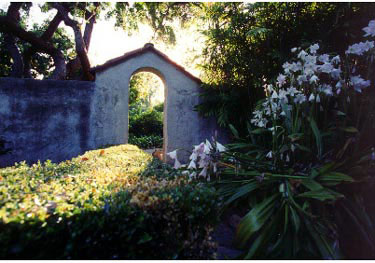
The Gardens
The villa’s gardens, explained Molly Barker, are a primary factor in Casa del Herrero’s brand new status as a National Historic Landmark. Landscape architects Ralph Stevens, Lockwood de Forest, and Francis Underhill created an impressively expansive, yet homey grounds surrounding the casa. On my tour, the guide walked us through the Spanish patio, the English flowerbeds, the French rose garden, the “Italian Rooms” (which are thick vines knotted over a trestle forming a formidable ceiling over relaxed wooden benches), and even the cactus garden, which was novel and exotic for its time. The faint sound of water is everywhere, thanks to slow-moving fountains that adhere to the classic Persian aesthetic. St. Francis can also be found sneaking about the garden, cast in stone, peeking out from behind trees and basking in Mrs. Steedman’s camellias. Another highlight of the garden is one of the world’s largest examples of the rare dragon tree, a native of the Canary Islands famous for producing the red sap that gave Stradivarius violins their iconic hue.
According to our guide, the work needed to complete and maintain the grounds was extensive, and Steedman worked to make sure he hired as many as he could during the Depression. He always fed his employees on workdays from the enormous barbecue he designed and forged himself in steel. The tour ends in the Steedman workshop, where he made tables and chairs, and took up silversmithing in his spare time.

Making a Landmark
After my tour, Barker explains the time-consuming process required to prove to the United States government that the casa was worthy of being named a landmark, specifically the production of a 57-page application. “It’s been such an incredible collaborative effort,” said Barker of her work with fellow foundation members Robert Sweeny and Susan Chamberlin. Barker reminds those interested in the tour that reservations must be made, to keep the tours small.
With beautiful rooms filled with the misery of martyrs and the smiling faces of the Steedmans in old photos, the tour is impressive and delightful. How Steedman found such comfort in gloomy panels and paintings of tragic lives is hard to understand, but it makes him all the more appealing. The entire estate seems to have been well loved, and the look into California history is engaging and worthwhile.
A book is being published by Sweeny this year, so all can remember the life and home of the powerful and interesting family. Personally, I prefer to remember Steedman at his most endearing: as a tiny cupid centaur in the casa’s guest bedroom, slaying a dragon with an arrow.



